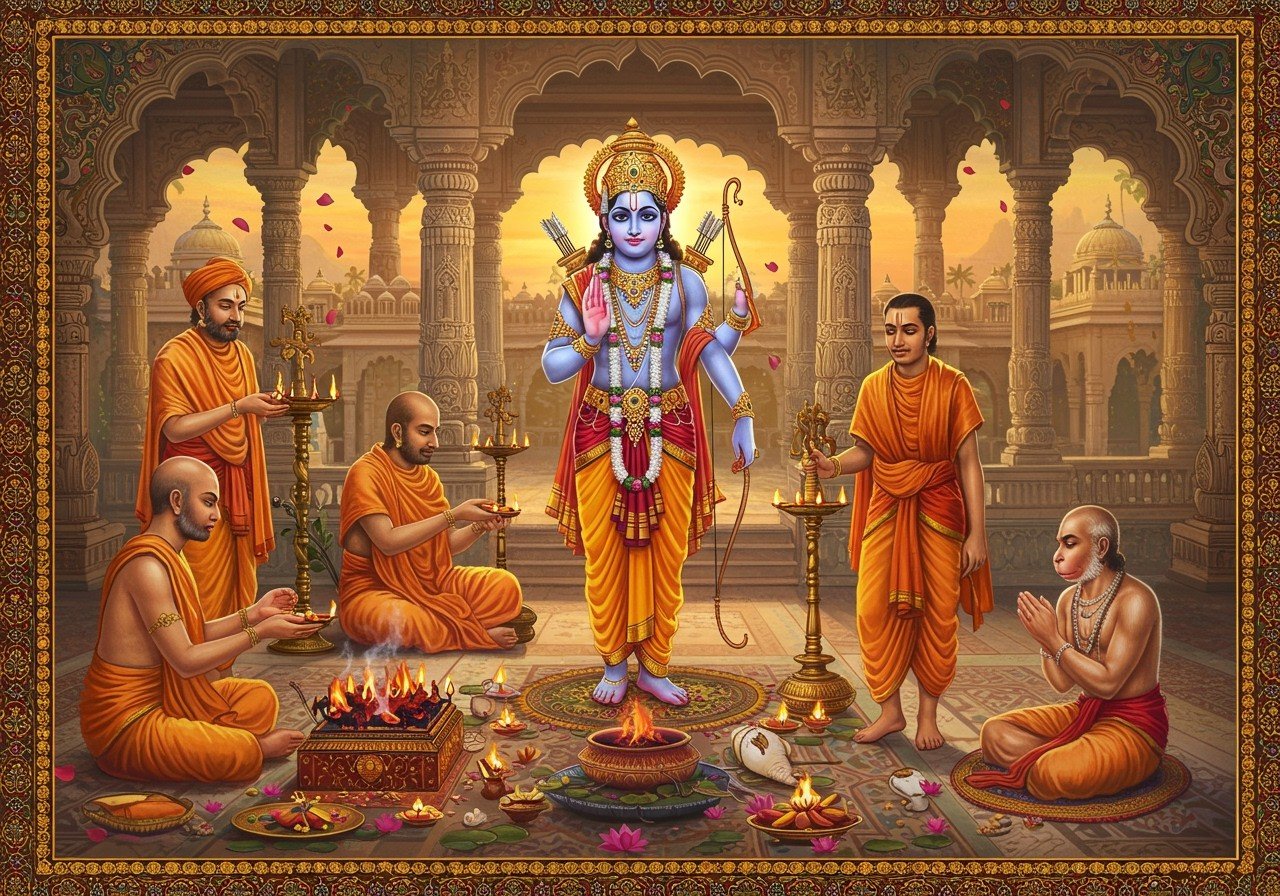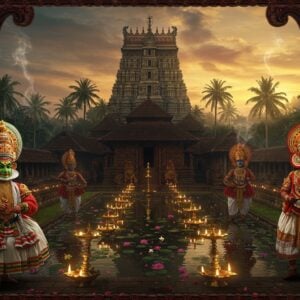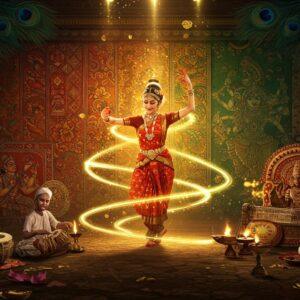
Step into the vibrant world of Ramanandi Vaishnavism, a revered sect within Hinduism. With roots tracing back to the influential saint Ramananda, this tradition emphasizes deep devotion to Lord Rama and Sita as the Supreme Absolute. Explore the rich tapestry of cultural and spiritual practices that define this community, from the daily rituals that connect individuals to the divine to the joyous festivals that unite millions in celebration across the globe. Discover how these traditions, passed down through generations, continue to thrive and resonate in modern life.
Key Festivals: A Celebration of Devotion
The Ramanandi Sampradaya observes a calendar rich with festivals, each holding unique significance and celebrated with vibrant enthusiasm. These occasions are not merely rituals; they are expressions of deep faith, cultural heritage, and community bonding.
- Ram Navami: This joyous festival marks the birth anniversary of Lord Rama. Celebrations often involve readings from the epic Ramayana, enacting scenes from Rama’s life (Ram Leela), and vibrant processions filled with devotional fervor. It’s a time to reflect on Lord Rama’s exemplary life and teachings.
- Diwali: The festival of lights holds special meaning for Ramanandis. It symbolizes the triumph of good over evil, echoing Lord Rama’s return to Ayodhya after his victory over Ravana. Homes are illuminated with diyas, prayers are offered, and families share festive meals, strengthening bonds of love and togetherness.
- Holi: A riot of colors and joy, Holi in the Ramanandi tradition celebrates the divine love of Radha and Krishna. The playful spirit of the festival resonates with the joyful aspect of bhakti (devotion). People sing, dance, and share sweets, creating a vibrant atmosphere of unity and celebration.
- Makar Sankranti: This harvest festival is a time to offer gratitude to the Sun God. Devotees offer prayers and gifts, acknowledging the sun’s vital role in sustaining life. It’s a time of reflection and appreciation for the abundance of nature.
- Ramananda Jayanti: This day honors the birth of the sect’s founder, Saint Ramananda. Devotees mark the occasion with enlightening discourses, discussions on his teachings, and acts of community service, carrying forward his legacy of compassion and inclusivity.
- Shivaratri: Uniquely, while being a Vaishnava sect, Ramanandis also celebrate Shivaratri, demonstrating their inclusive approach to spirituality. This festival is dedicated to Lord Shiva, acknowledging him as an important deity.
These festivals are integral to the Ramanandi way of life, offering a blend of spiritual reflection, cultural expression, and joyous celebration. They serve as a bridge connecting the past with the present, ensuring the continuity of traditions for generations to come.
Daily Rituals and Sacred Ceremonies: A Path to Devotion
Beyond the grand festivals, the daily practices of Ramanandis form the foundation of their spiritual lives. These rituals and ceremonies are not mere routines; they are pathways to connect with the divine and cultivate inner peace.
- Chanting of Ram Naam: The simple yet powerful practice of chanting Lord Rama’s name is central to Ramanandi devotion. It’s a constant reminder of the divine presence and a source of solace and strength in daily life. Repeating Ram Naam is believed to purify the mind and bring one closer to God.
- Recitation of Sacred Texts: Devotees find profound meaning and guidance in the sacred texts, particularly the Ramayana. Reading and reflecting on these scriptures deepens their understanding of Lord Rama’s life and teachings. These stories provide moral guidance and inspiration for everyday living.
- Satsang: Community gatherings, or Satsangs, are essential for spiritual growth. Devotees come together for collective chanting, discussions, and sharing of spiritual experiences. This fosters a sense of belonging and mutual support on the spiritual path. The collective energy of Satsang amplifies the spiritual experience.
- Bhajan and Kirtan: Devotional singing is a joyous expression of love for the divine. These melodious prayers uplift the spirit and create an atmosphere of devotion. Through Bhajan and Kirtan, devotees express their love and devotion to God. This is seen as a potent way to connect with the divine.
- Diksha (Initiation): This sacred ceremony marks a formal commitment to the Ramanandi path. Gurus impart sacred mantras to their disciples, guiding them on their spiritual journey. Diksha is a significant step, deepening the devotee’s connection to the lineage and teachings.
- Pilgrimages: Journeys to sacred sites, especially Ayodhya, the birthplace of Lord Rama, hold immense significance. These pilgrimages strengthen the devotee’s bond with Lord Rama and provide opportunities for deep reflection and spiritual renewal. Visiting sacred places is seen as a way to purify karma and receive blessings.
Significance of Ramanandi Practices
The celebrations and rituals of the Ramanandi Sampradaya are more than just traditions; they are living expressions of faith, community, and personal growth. They carry profound significance in shaping the lives of devotees.
- Community Building: Festivals bring people together, fostering a sense of belonging and shared identity. They create opportunities for devotees to connect with each other, share experiences, and strengthen the bonds of community.
- Preservation of Culture: The traditions and rituals passed down through generations serve as a living heritage, ensuring the continuity of culture and values. They connect devotees to their roots and provide a sense of identity. The vibrant celebrations help to preserve these practices for future generations.
- Personal Spiritual Growth: Rituals and practices provide a framework for personal spiritual development. They cultivate discipline, focus, and a deeper connection with the divine. The act of regular practice can lead to greater self-awareness, inner peace, and a sense of purpose. It can also help devotees navigate the challenges of life with greater resilience.
- Adaptability to Modern Life: While deeply rooted in ancient wisdom, Ramanandi traditions seamlessly integrate into contemporary lifestyles. This adaptability ensures their relevance in a rapidly changing world, allowing individuals to connect with their spiritual heritage while living in the modern context.
A Practical Guide to Participation
Embarking on a journey with the Ramanandi Sampradaya is a rewarding experience. Here’s a guide to help you participate and connect with this vibrant community:
- Online Resources: Explore online communities and websites dedicated to Ramanandi Vaishnavism. These platforms offer a wealth of information about the sect’s teachings, practices, and upcoming events. Virtual Satsangs are also available, allowing for global connections and shared learning. This is a great way to learn more about the tradition and interact with fellow devotees.
- Sourcing Authentic Puja Items: You can easily find authentic puja items online through reputable stores like Poojn.in. Having the right items enhances the authenticity of your personal rituals. Creating a simple home altar allows for daily practice and reflection, bringing a sense of sacredness into your space.
- Local Events: Connect with local Ramanandi communities and participate in events and gatherings. This provides firsthand experience of the community’s spirit and allows for personal connections with fellow devotees. This is a great way to deepen your involvement and learn from experienced practitioners.
How Poojn.in Supports Your Ramanandi Celebrations
Poojn.in, India’s largest Dashakarma bhandar, simplifies your access to authentic puja items for all Ramanandi Sampradaya rituals and festivals. We offer a wide selection of essential items:
Essential Puja Items:
- Pure copper lota
- Tulsi mala
- Traditional aarti thali sets
- Pure ghee diya and batti
- Gangajal
- Tulsi wood chandan
- Cotton wicks
Festival-Specific Items:
- Ram Navami puja samagri
- Hanuman Jayanti items
- Special tulsi archana sets
- Prasad items (batasha, mishri)
Connect with us:
- Website: www.poojn.in
- Phone: 03369029784
- WhatsApp: 9476142738
We ensure:
- 100% authentic products
- Careful packaging
- Pan-India delivery
- Expert guidance
- Bulk orders for temples and institutions
All our products are verified for purity and adherence to Ramanandi Sampradaya traditions. We maintain strict quality standards for all ritual items, especially those used in deity worship and prasad preparation.
Embracing the Ramanandi Way
Stepping into the world of the Ramanandi Sampradaya is an enriching experience. It offers a path where ancient wisdom meets modern life, where devotion intertwines with daily practice. As you explore this tradition, remember to approach it with respect and an open heart, allowing the timeless teachings of Ramananda to guide you. Each chant, each gathering, and each festival celebrated strengthens your connection to the divine. Embrace the convenience of online resources and connect with local communities. Allow the warmth and unity of the Ramanandi Sampradaya to enrich your spiritual journey.
FAQs: Your Guide to Ramanandi Festivals and Rituals
What are the key festivals celebrated in the Ramanandi Sampradaya?
Ram Navami, Diwali, Holi, Makar Sankranti, Ramananda Jayanti, and uniquely, Shivaratri are key festivals. Each celebration has deep spiritual significance and cultural richness.
What rituals are commonly practiced?
Daily rituals include chanting Ram Naam, reciting sacred texts, and attending Satsangs. Ceremonies like Diksha (initiation) and pilgrimages to sacred sites also hold great importance. Specific rituals are observed during festivals, adding to their vibrancy.
Why is Ram Navami so important?
It marks the birth of Lord Rama, a central figure of devotion in the Ramanandi Sampradaya. Celebrations are filled with reverence, reflecting deep love and respect for Lord Rama.
How do Ramanandis celebrate Diwali?
Diwali, the festival of lights, is celebrated with diyas, prayers, and family gatherings. It symbolizes the victory of good over evil, resonating with Lord Rama’s return to Ayodhya.
What is the significance of Holi?
Holi is celebrated with vibrant colors, music, and dance. It symbolizes the triumph of good over evil and celebrates the divine love of Radha and Krishna. The festival’s playful spirit reflects the joy of devotion.
How is Janmashtami observed in the Ramanandi tradition?
Janmashtami celebrates the birth of Lord Krishna with fasting, devotional songs, and midnight pujas. It emphasizes spiritual teachings and the playful aspects of the divine.
Why are rituals important in Ramanandi festivals?
Rituals are a vital part of connecting with the divine and expressing devotion. They offer a path to spiritual growth and deeper understanding. They connect devotees to their spiritual heritage and strengthen their faith.
What role do community gatherings play?
Community gatherings foster a sense of belonging and shared purpose. They create opportunities for learning, sharing experiences, and strengthening bonds within the Ramanandi Sampradaya.
Ram Navami Celebration
Understanding the Hindu Calendar
Ramayana Festivals
Symbolism and Teachings in the Ramayana
Vamavarti Shankh
Laddoo Gopal


